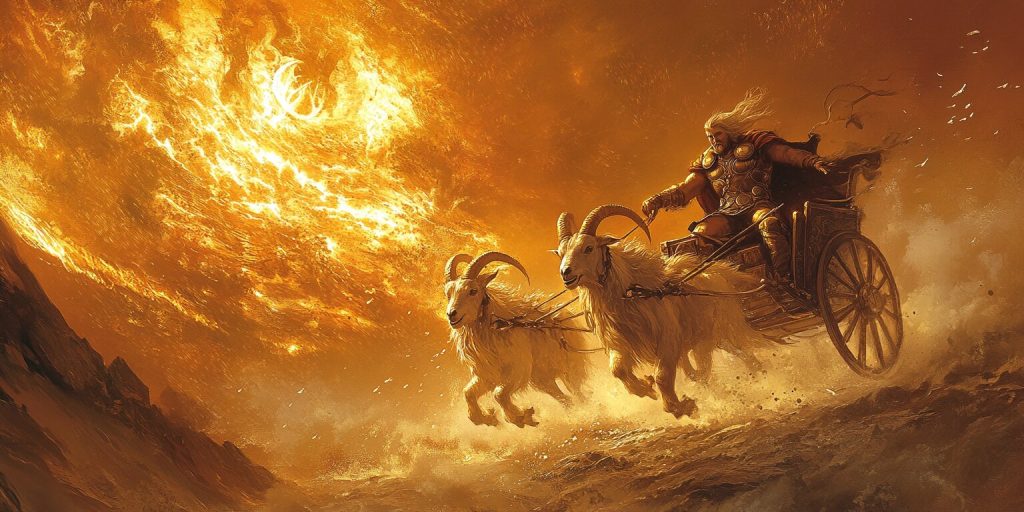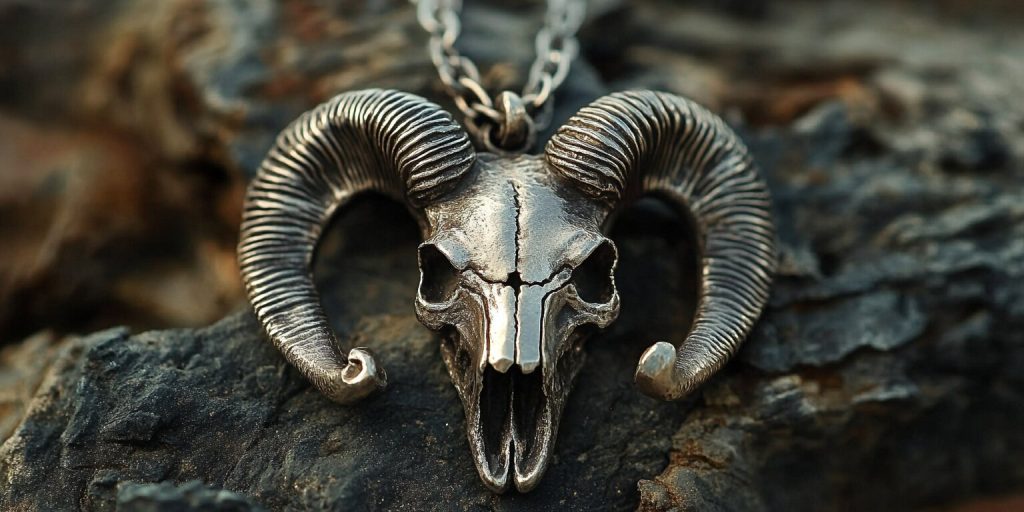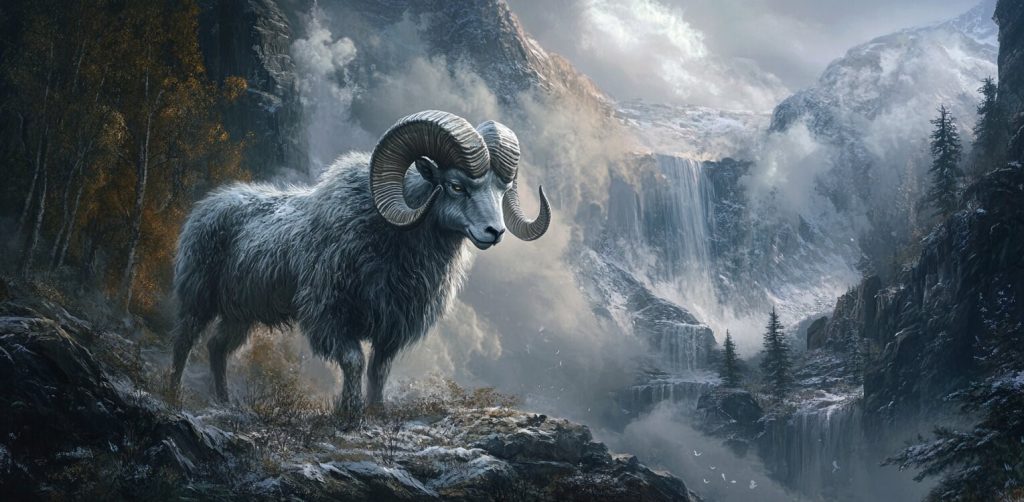Aesir Gods, Creatures in Norse mythology, Mjölnir (Thor’s Hammer), Norse Gods, Norse Mythology, Norse Symbols, Odin, Tanngrisnir and Tanngnjóstr, Thor, Viking Clothing and Jewelry
The Norse Ram: Symbolism and Mythology of the Sturdy Beast
The Norse ram is a powerful symbol in Norse mythology and Viking culture. It stands for strength, resilience, and a magical charm. It is deeply linked to gods like Thor and Odin, which shows its great importance.
This ram is more than just a farm animal. It is a symbol of bravery, living through harsh Scandinavian weather. Old stories and artifacts show their role in daily life and spiritual beliefs. Scholars also talk about its protective powers, especially in relation to Viking beliefs and futhark runes.
Through symbols and worship items, we see the ram’s spiritual and protective sides. Scholars today still study the ram’s impact on our culture, particularly in Old Norse literature. Exploring these topics shows us the deep meaning of the Viking ram in Viking culture and today.
The Norse Ram in Viking Culture
The Norse ram and the Viking goat were important in the Viking Age. They were part of daily life and spiritual beliefs. These animals provided essential things like wool, meat, and milk. They also showed social and domestic status.
Significance in Daily Life
Rams were key to daily needs, offering food and economic support, much like sheep in Viking society. They were seen as symbols of wealth and power, and Viking farmers valued them highly.
Rams also appeared in myths, demonstrating their high status in society. They were involved in rituals and events linked to fertility and good luck.
Depictions in Artwork and Carvings
Rams were often seen in Viking art and carvings. Archaeologists found them on rune stones, which they were thought to protect. Ships had ram symbols, too, helping sailors find their way safely.
Artisans portrayed rams on everyday items. Horn carvings and other artifacts from the time often showed the ram, which proves how important it was in Viking culture.
Mythological Roles of Rams and Goats
In Norse mythology, rams and goats play a big role. They are key symbols in many stories and poems, often depicted as the Norse or Celtic ram head. They are linked to powerful gods and symbols of the Norse world.
Thor’s Chariot: The Association with Norse Goats
Thor, the god of thunder, is closely tied to rams and goats, which were often depicted in Norse art, including chain necklaces. He uses a chariot pulled by magical goats named Tanngrisnir and Tanngnjóstr, reminiscent of the legendary Mjolnir. These goats can be killed and brought back to life, showing the cycle of life and strength.

This story shows how much the Norse people valued the Norse goat.
The Symbolic Norse Goat and Ram
Rams and goats were also important in rituals, symbolizing fertility and good luck among the Vikings. They were often sacrificed to honor the gods, which shows how special they were.
Rams were seen as symbols of strength and bravery. The ram skull was a common image in Viking art. Together, goats and rams formed a symbol of Norse power and legacy.
The Norse Ram as a Symbol
The Norse ram is a key figure in Norse Viking culture. It stands for strength and endurance needed for the North’s tough climate. Its toughness and strength are celebrated, making it a strong symbol of these traits.
Strength and Endurance
The ram is highly respected for its huge strength and never-give-up spirit, qualities admired by the Vikings. It could face harsh conditions, making it a symbol of perseverance in Norse Viking societies. The ram’s ability to keep going showed humans how to face big challenges.
Protective Qualities and Guardian Roles
In Norse mythology and culture, the ram is seen as a guardian. It protects homes, farms, and villages. As a totem, the Norse ram offered physical safety and spiritual protection. It gave courage and resilience to warriors and everyday people.
Connection to Norse Gods and Mythological Figures
The Norse ram’s traits match those of many Norse gods. For example, its strength and endurance are like Thor’s hammer, Mjolnir. Its protective roles are similar to Odin’s, who is known for his wisdom and protection. These links deepen the ram’s symbolism in Norse myths and rituals.
Rams in Norse Jewelry and Artifacts
Rams were more than just figures in Norse myths and art. They were highly valued in jewelry and artifacts. Their symbols were important in daily life and spiritual beliefs.
Ram Skull Pendants and Necklaces
Ram skull pendants were a big part of Viking jewelry. Made from silver and bronze, they carried deep meaning. Wearing one showed strength and manliness. These pieces, like the Norse ram head pendant and chain necklaces, were both beautiful and meaningful.

Viking Rings and Bracelets Featuring Ram Designs
Viking rings and bracelets often had ram designs. These items were more than just to wear. They were seen as talismans that brought protection and luck. Each piece was carefully made to look good and be important.
Significance of Ram Motifs in Viking Age Jewelry
Ram symbols in Viking jewelry meant a lot. They stood for protection, status, and identity. Like a necklace or bracelet, every piece told something about the wearer. These designs showed how Norse people used art to express themselves and their culture.
Comparing Norse and Celtic Ram Symbolism
Exploring Norse and Celtic cultures reveals the deep meanings of the ram. Both traditions consider the ram very important and have their own ways of seeing and using its symbolism.
Norse vs. Celtic Ram Head Necklaces
Ram-head necklaces show the unique styles of Norse and Celtic art. Norse ones are often crafted with runic designs, while Celtic ones have complex designs and knotwork. This shows their skill in metalwork and their deep symbols.
Norse ones are often simpler but strong, showing Viking values of strength. Yet, both kinds of necklaces are seen as powerful symbols. They stand for protection and bravery.
Shared Symbolic Meanings
Even though they look different, the ram symbolizes strength, leadership, and protection in Norse and Celtic cultures. These common meanings show how much both cultures value the ram’s qualities.
The ram is a strong symbol, whether a Celtic necklace or a Norse artifact. It represents these important virtues.
Distinct Cultural Interpretations
The way the ram is seen in Norse and Celtic cultures tells us a lot about their beliefs. For the Celts, the ram connects to nature and mysticism. It’s linked to fertility and the changing seasons.
In Norse culture, the ram is part of their stories and gods. For example, Thor’s chariot has goats, showing the ram’s role in stories of hardiness and adventure.
The Norse Ram in Modern Culture
The Norse Ram’s story lives on in today’s culture, especially in jewelry making. Artisans and sellers draw inspiration from old designs.
Modern Viking Jewelry Inspired by Norse Rams
Modern Viking jewelry includes ram pendants and horned items. They mix old symbols with new styles and materials. The Norse ram pendant, made of stainless steel, is a great example, blending history with modern looks.
People collect these pieces for their beauty and deep Norse mythological meaning.
Ram Symbolism in Contemporary Viking Enthusiast Circles
Today’s Viking fans, in groups and pagan communities, still value the ram’s symbolism. They wear jewelry with ram designs. These pieces remind them of strength, safety, and lasting through tough times.
These items keep the old traditions alive, including Viking earrings and other jewelry craftsmanship. They let fans show their bond to Norse culture in a real way.
Conclusion
The Norse ram’s journey through history shows its big impact on Viking culture and today’s world. This strong creature was a key symbol of strength and safety. It played big roles in myths, pulling Thor’s chariot and guarding others.
Art and jewelry from Viking times show how much the ram meant to them. Designs on pendants and rings tell us about their importance. Today, ram symbols are still popular in art and accessories, loved by many.
The Norse ram went from being just an animal to a powerful symbol. It shows strength, lasts a long time, and protects. This symbol still moves us today, showing that old symbols can still mean a lot to us. The Norse ram is more than history; it’s a symbol that connects us to Viking culture and its lasting impact, often represented in jewelry like Viking bracelets.

